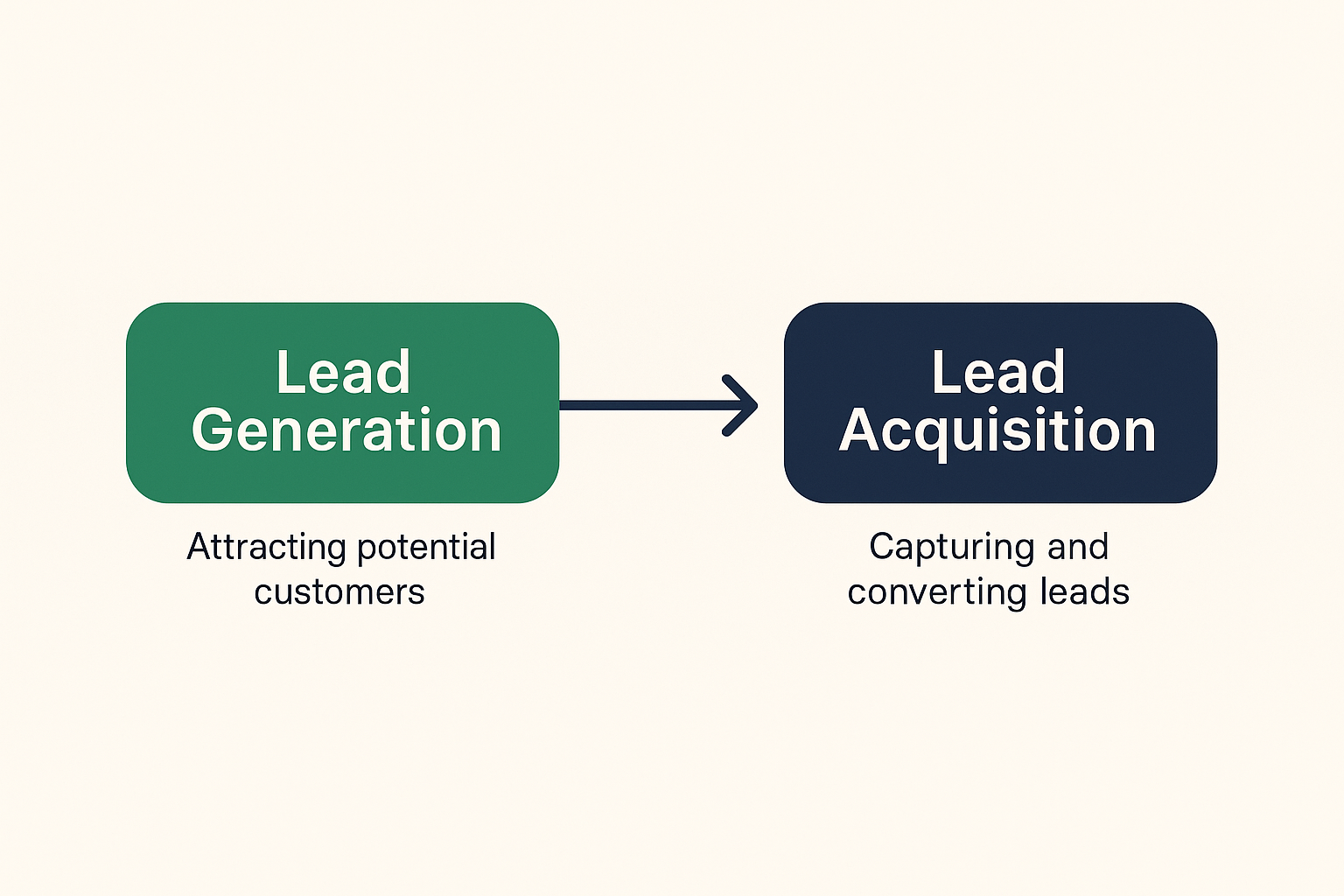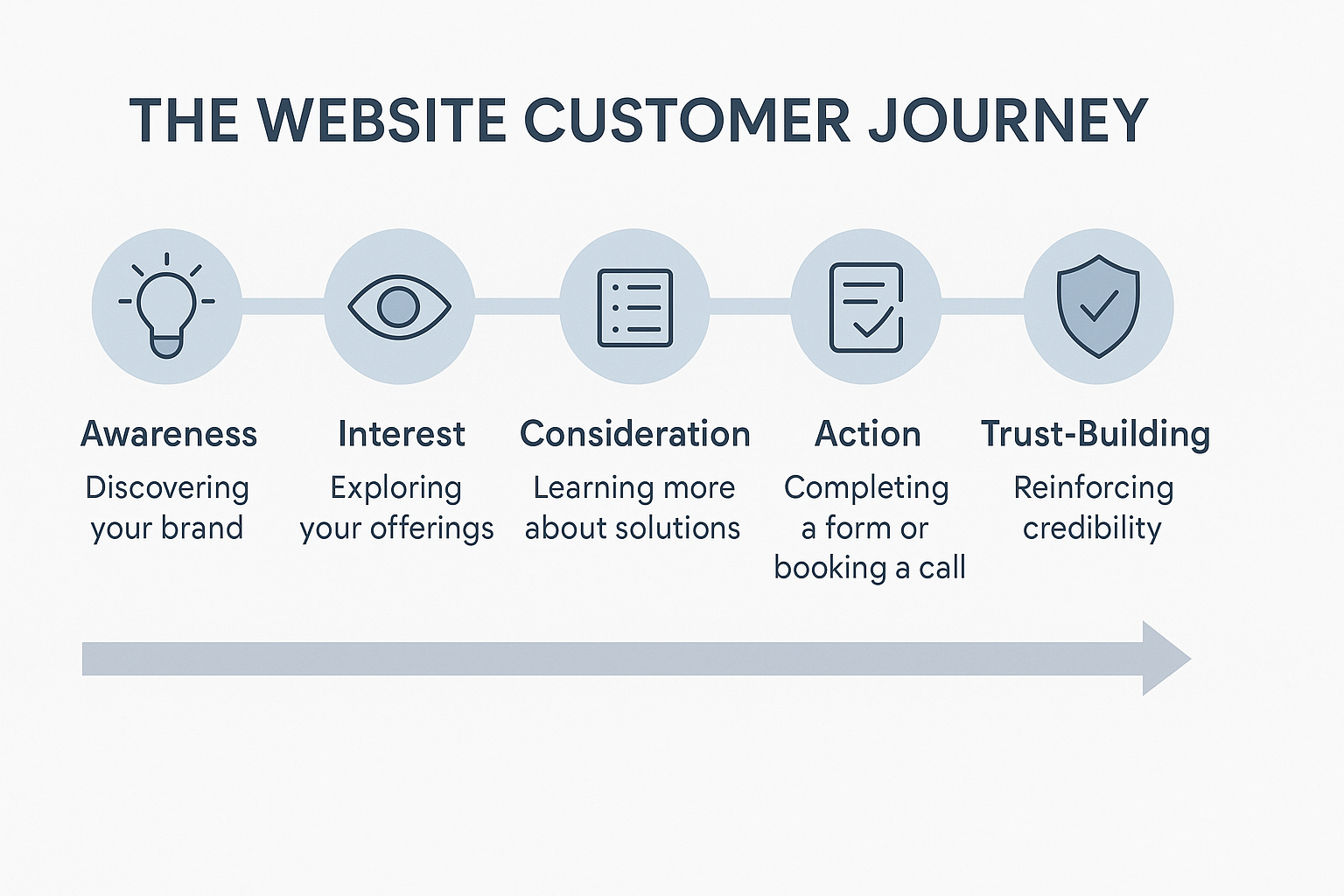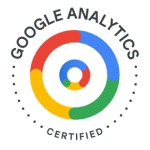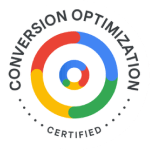The Lead Acquisition Marketing Guide
A practical guide for B2B teams to improve website lead acquisition using clear strategy, GA4 tracking, and meaningful KPIs—cutting waste and increasing qualified leads.
What is Lead Acquisition Marketing?
Lead acquisition marketing is often misunderstood as simply "getting more leads". In reality, it's about building a deliberate strategy that helps your business attract qualified leads – the kind that are more likely to convert, and more aligned with your ideal customer profile.
When we talk about acquisition, we’re not talking about casting a wide net. It’s about targeting the right audience with the right messaging, at the right point in their decision-making journey. This is a key distinction from broader lead generation activities that may prioritise volume over quality.
Why does Lead Acquisition matter?
So, why does lead acquisition matter? Because it creates a more consistent and sustainable flow of inbound interest – helping marketing and sales teams work from the same playbook. Done well, it supports revenue growth, improves conversion rates, and gives marketing teams the insight they need to continually optimise performance.
A good lead acquisition strategy is tightly aligned with business objectives. It uses SEO, PPC, website content, and email marketing to meet your target audience where they are – and it uses data and tracking tools like GA4, Search Console, and CRM platforms to refine efforts over time.
In other words, lead acquisition marketing is the engine behind B2B pipeline growth. And if your current marketing activity isn’t generating enough quality leads, it might be time to take a fresh look at how your strategy is built.
Lead acquisition marketing is the engine behind B2B pipeline growth
Is it time for a fresh look at your strategy?
We can help with lead acquisition strategies
Inbound vs Outbound Marketing and Lead Acquisition
It’s worth being clear about the difference between inbound and outbound marketing — and how both can play a role in a lead acquisition strategy.
Inbound marketing is about attracting potential customers to you. It relies on helpful, high-quality content, search engine visibility, and website journeys that convert. It should pull in the right audiences organically, making it easier to build trust and qualify leads from the start. These leads are already looking for your services, and therefore should prove easier to convert and provide a higher ROI.
Outbound marketing, on the other hand, pushes your message out. Think email campaigns, targeted ads, or direct outreach. It’s more immediate, but less forgiving — especially in B2B, where decision-makers are bombarded with messages every day. Outbound relies on your content being in front of the right person at the right time. Ensure your outbound data is relevant and accurate, because the more targeted and personalised you can be, the more effective your marketing will become.
We generally advise clients to start by strengthening their inbound foundations. That includes auditing their SEO, creating optimised and relevant content, completing their analytics setup and building a robust customer acquisition strategy. When that’s working, outbound can then be layered in to support very specific campaigns or account-based approaches — with a clearer view of what “good” looks like.
Ultimately, the best strategy for lead acquisition isn’t one-size-fits-all. It’s bespoke to the business, built on data-driven decision making, and designed to evolve as your audience, products and markets change.
Inbound vs Outbound Marketing
Examples of Inbound Marketing Activities
- Publishing SEO-optimised blog content
- Using organic social media to share insights and updates
- Using GA4 and Looker Studio to refine high-performing user journeys
- Creating lead magnets (eBooks, whitepapers, templates)
- Setting up conversion-focused landing pages and forms
Examples of Outbound Marketing Activities
- Cold email campaigns to targeted company lists
- Direct mail campaigns (physical or digital)
- Trade show follow-up campaigns
- Launching ABM (Account-Based Marketing) email or ad campaigns
- Paid social media marketing
Train your marketing teams
Our training covers all aspects of inbound and outbound marketing
Lead Acquisition vs Lead Generation — What’s the Difference?
Lead generation
The broad process of attracting potential customers to your business — typically through a mix of content marketing, advertising, SEO, and social media. It’s all about sparking interest and starting conversations.
Lead acquisition
On the other hand, lead acquisition focuses on how you capture, qualify and convert those leads into your pipeline. This includes the tools, journeys, and data-led tactics that make sure your efforts aren’t just creating traffic — but delivering genuinely interested prospects your sales team can work with.
In short: lead generation brings them in, lead acquisition turns that interest into something measurable and actionable.

Why the Website Customer Journey Can Make or Break Lead Acquisition
The customer journey refers to the path a user takes through your website, from their first interaction (often a landing page or blog post) through to a meaningful action — such as filling in a contact form, booking a demo, or downloading a resource. That journey might span multiple pages and include various touchpoints: service pages, testimonials, case studies, pricing information, and calls to action. When designed well, the journey feels seamless, relevant, and reassuring. When it isn’t, the result is friction, confusion, and lost opportunities.
A well-structured customer journey guides visitors towards the right decision at the right time. It anticipates their questions, removes blockers, and reinforces trust. It’s not just about having a ‘Contact Us’ button in the right place — it’s about ensuring the experience aligns with their intent, their stage in the buying process, and their need for reassurance.
When the journey is confusing or disjointed, it shows. Visitors drop off early, conversion rates stall, and even well-targeted campaigns fail to deliver ROI. Worse still, a poor website experience can damage brand perception. If your digital presence doesn’t reflect the professionalism of your service, that disconnect undermines confidence — especially in B2B, where trust often needs to be built well before any direct contact.
At Arboreal Marketing Ltd, we often find that small changes to layout, messaging, or structure can have a disproportionate impact on performance. That’s why we always look at the customer journey in the context of data. Where are people dropping off? Which pages are doing the heavy lifting? Are there dead ends or distractions along the way? These insights help us uncover where the real problems are — and how to prioritise improvements that will make a measurable difference and increase your lead acquisition.
Improving the website journey isn’t about redesigning everything from scratch. It’s about optimising what you already have — aligning content with user intent, guiding attention where it matters, and creating a seamless experience that builds confidence with every click.
If your current site isn’t converting enough of your traffic, it might not be a traffic problem. It might be a journey problem. And if that’s the case, we’re here to help you fix it.
Improving the website journey isn’t about redesigning everything from scratch. It’s about optimising what you already have
Mapping Lead Acquisition and the Customer Journey
Understanding the customer journey is critical – but it doesn't need to be overwhelming.
At its simplest, the customer journey is the path a user takes from landing on your website to completing a goal. In B2B environments, this journey can be long, multi-touch, and heavily influenced by content. It’s important early on to set your strategy in place and then measure against fixed KPIs, to protect the business from expensive guesswork.
A great place to begin is Google Analytics 4 (GA4). It’s not perfect, but it is powerful. Start by setting up key events: consider things like form completions (form_submit events), page views on thank you pages, time spent on high-intent pages, and downloads of lead magnets. From there, use GA4’s “path exploration” feature to see what users do before converting – or dropping off. Google Search Console will also provide insight into your search engine performance, you can double check your pages are indexed and see how well your blog posts are performing. It’s not as comprehensive as a professional SEO tool such as SEMRush or Moz, but it is free and gives you somewhere to start.
There are also many tools available that offer AI lead generation, or automated lead acquisition. They have their place as part of a dedicated lead acquisition marketing strategy, but they aren’t magic, if your content isn’t tailored and fit for purpose – these systems just won’t work. Tools should support your team, not replace it. Your marketers still need to understand the “why” behind the data – and that means being close to the customer, interpreting trends and not just collecting figures.
Also – don’t be a Magpie! It’s easy to be tempted by shiny new platforms that promise silver-bullet results. Heatmaps, session replays, AI chat tools… they all have a place. But without a clear strategy, you risk creating noise, adding cost and increasing workloads instead of landing leads and producing insight.
Focus on the fundamentals:
- Are we creating high-quality, useful content that matches customer intent?
- Are we clear on where we want visitors to end up?
- Are visitors moving through the site in the way we expect?
- Where are the friction points?
- Can we see where we lose them or where they get lost?
At Arboreal Marketing, we offer training programmes to upskill your marketing team on GA4 and SEO, or we can deliver full conversion optimisation audits and projects. Whichever route you choose, our priority is the same as yours: to get more value from your existing website visitors.

It’s important early on to set your strategy in place and then measure against fixed KPIs, to protect the business from expensive guesswork.
Are you interested in bespoke training for your team
We tailor our training to your exact requirements
Setting KPIs for Lead Acquisition – And Knowing What to Ignore
So, your website is running, your content is live, and GA4 is collecting data. Great. Now what?
You need to set Key Performance Indicators (KPIs) that align with your business objectives – and more importantly, actually help your team make profitable decisions
For B2B websites, here are a few core metrics worth focusing on:
1
Conversion Rate (CVR)
The percentage of visitors who complete a lead action (form fill, contact click, download, etc.). This is calculated by taking all conversions and dividing it by the number of website visitors in your chosen time period.
2.
Cost per Lead (CPL)
Especially relevant if you’re using paid media – what’s the real cost of generating a new enquiry? A true cost per lead should include the offline costs of your team, meeting times with prospects, any travel costs as well as advertising or running costs.
3.
Engagement Rate
GA4’s engagement metrics (engaged sessions, average engagement time) are more useful than simple bounce rate. This will show you which pages are heroes and which need more investment.
4.
Time to Conversion
How long does it take for a visitor to become a lead? This can help identify friction in your journey
5.
Lead Quality
Are your leads actually qualified? This might be subjective, but your sales team will have strong opinions. How much of your acquisition is churn or wasted PPC enquiries? A high percentage will indicate website content or PPC execution isn’t aligned to the target audience correctly.
Lead Acquisition Benchmarks
If you're wondering what "good looks like" then these average B2B website benchmarks may help. They are compiled from a number of different sources and represent UK B2B averages between 2023 and 2025.
- Conversion Rate (CVR) - 1.5% - 3%
- Cost Per Lead (CPL) - £50 - £150
- Website Engagement Rate - 55% - 70%
- Average Engagement Time - 59 seconds
A word of caution: don’t fall into the trap of analysis paralysis.
It’s easy to spend hours slicing and dicing dashboards – but if you’re not taking action, what’s the point?
Choose 3–5 meaningful KPIs that your team understands, and revisit them monthly. The goal isn’t to be perfect – it’s to get better. Incremental improvement can provide benefits quickly, especially when aligned with business goals, and the improvement of marketing team morale should not be underestimated either.
If you're unsure where to start, that’s exactly where Arboreal Marketing comes in. We help B2B organisations clarify their customer acquisition strategy, we can build useful dashboards, and – most importantly – turn insight into action.
Choose 3–5 meaningful KPIs that your team understands, and revisit them monthly.
We can help you increase your lead acquisition
Our conversion optimisation projects can take your website to the next level
Benefits of Strong Lead Acquisition Marketing
In summary, lead acquisition marketing is a refined skill that teams must invest in developing. Understanding the customer and taking full ownership of the digital customer journey is essential in ensuring that your website traffic and marketing spend is delivering the leads you need to meet your organisational objectives. The key to success lies in a robust strategy, and allowing your marketing team to use their expertise to monitor, measure and adapt acquisition channels to provide the right level of qualified traffic.
Strong lead acquisition results in more efficient marketing channels, reducing reliance on expensive paid media and creating an improved and sustainable lead funnel. If your current lead acquisition strategy isn’t generating results then think about further training for your team in SEO, GA4 and Conversion Optimisation, expert support from our CRO consultant or content creation to align your website closer to your target audience.
Arboreal Marketing Ltd can provide all of these services – so speak to us today to find out more.
Lead acquisition marketing is a refined skill that teams must invest in developing
Lead Acquisition Marketing: Frequently Asked Questions
How long can it take to see results from lead acquisition marketing?
This will vary based on the different marketing tactics or acquisition channels you use. A dedicated and effective SEO strategy can deliver results from around 3 months, and fully impact from 6 months – whereas a PPC campaign, while costly, can produce leads within weeks.
Can my team be trained on GA4 and lead acquisition strategy?
Yes! At Arboreal Marketing Ltd, we offer bespoke digital marketing training, with sessions tailored to help your team understand GA4, mapping customer journeys and how to build sustainable acquisition strategies through SEO.
Learn more about trainingConverting Websites: How small conversion rate increases can save digital marketing budgets.
We can help you
Let us know what marketing challenges your business is facing and we'll be in touch to arrange an introductory call.
Tell us about your project




